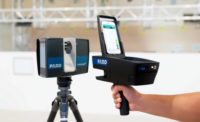Quality control can be held up by complex parts which take time to measure, internal issues such as non-compliance and rework, and external problems, such as customer complaints. These challenges slow down productivity.
Operators can boost measuring speed with 3D scanning tools. 3D scanners measure up to millions of points per second over a large field of view. The best scanners quickly gather without compromising quality.
When users want to measure parts directly inline, they should choose instruments capable of performing millions of measurements per second. For example, the typical cycle time — encompassing part loading, measurement, analysis, and unloading — in the automotive industry varies from 40 to 50 seconds.
Operators should use between four to eight 2D or 3D profilers for this type of work. The cameras take snapshots of incoming parts in mere seconds, and the acquisition and analysis processes only take seconds, helping operators to keep up with production while ensuring quality is in check.
However, this solution works best for static cameras.
Vibrations and temperature variations can change the volumetric accuracy, or the combination of the local accuracy of a 3D scanner and the accuracy of the position of each sensor.
If the distance between cameras changes, then the measuring system cannot compensate for it, giving faulty readings.
Instead of investing in expensive, non-flexible fixtures to avoid such problems, users should use external tracking devices. These optical technologies can track an object dynamically in real time and compensate for floor vibrations or fixture changes due to temperature variations.
Regardless of inline or at-line work, 3D scanners are faster than customary measuring machines. Because measurements are performed on the production floor, operators do not have to move parts to quality control labs. Therefore, they save time, and can fast-forward inspection results.
Operators have other inline quality solutions than metrology labs.
Automated, 3D scanning CMMs quality control devices can now be mounted on industrial robots. They are highly reliable, as this type of robot was originally designed to serve in “low mix-high volume” production and built to work at a higher speed and carry higher payloads than any metrology system.
Keeping a shop floor ready 3D scanning CMM close to the production line can save measuring time. 3D scanners are speedy, and operators do not lose time carrying parts to the quality control lab.
Turnkey solutions can save design time and operators don’t have to worry about integrating robotic cells.
Turnkey 3D scanning CMMs, which are comprised of robots and scanners, can boost productivity while facilitating a similar range of accuracy and volumetric precision to traditional solutions. This is a relief for quality control managers, who are not experts in robotics and can optimize repetitive tasks with this robotic component.







